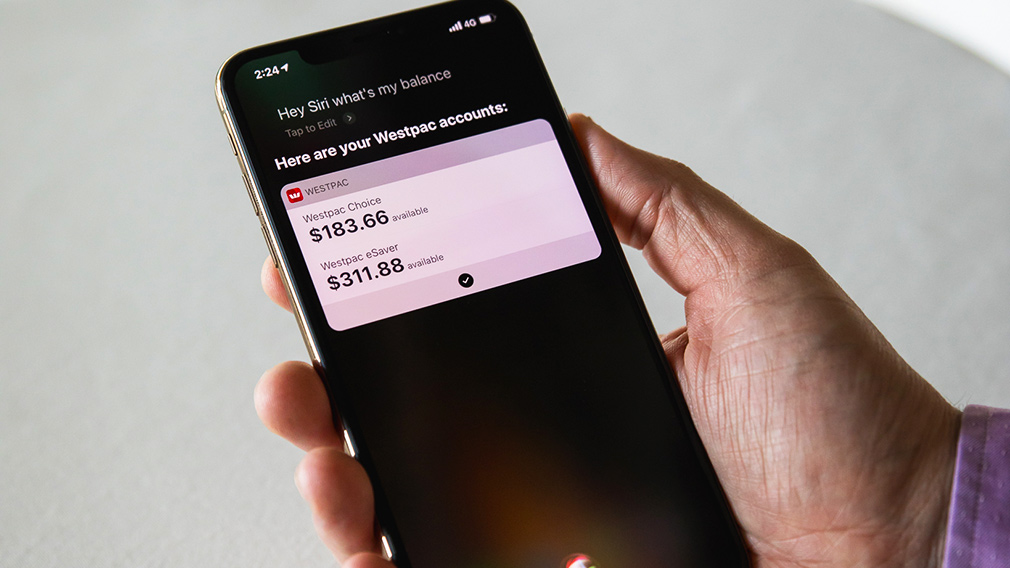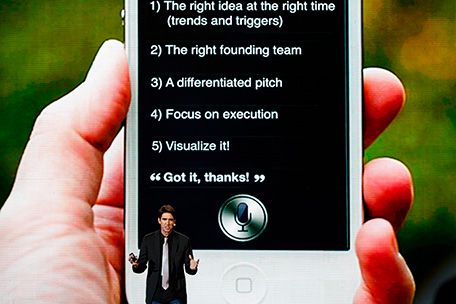‘Siri, are voice payments the next big thing?’

Siri for Westpac being trialled on the new iPhone Xs. (Grant Angus)
In the dynamic payments space, it’s hard to pinpoint exactly where voice-tech is at.
In January, Apple revealed to its legions of diehard followers that its Siri virtual assistant was “now actively used on over half a billion devices” after being integrated into the iOS operating system in 2011. But the revelation – unveiled in a release to launch its HomePod wireless speaker – didn’t divulge individual user numbers, frequency of use, their geography or what people usually do with Siri.
Locally, a PwC future of payments report looking at trends out to 2020 also didn’t mention voice technology or smart assistants, albeit noting that payments disruption was “still in its early stages”.
According to new research by Feedilicious, nearly half of Australian adult smartphone users use a voice assistant – a third relying on it daily – mostly to browse the internet, make calls or send text messages, and seek directions. A quarter also said they would be willing to transfer money via voice assistant if it was securely linked to their bank account.
The research, commissioned by Westpac, which today unveiled “Siri for Westpac”, found an even higher proportion, 67 per cent, would be likely to use a voice assistant to check their bank account.
It’s already possible to use Siri to transfer money via apps such as Square Cash or PayPal, while checking accounts can be done via smart assistants offered by various companies, including Amazon’s Alexa and Google Assistant.
But in a move that signals voice recognition technology usage across the industry will only increase, Westpac’s new functionality for Siri enables customers to link their transaction account and make payments to any payee set up in their app or online banking, authenticated by fingerprint or face ID before money is transferred.
The bank said it marked an Australian banking first, reflecting consumers’ rising use of Siri to “make their lives easier and faster”.

Siri co-founder and former director of engineering in the iPhone group at Apple, Adam Cheyer, speaking in Ukraine last year. (Getty)
Others are also delving deeper into the voice-tech space, Deloitte this week acquiring Melbourne-based speech analytics provider KnowledgeSpace to provide “better and deeper insights” into customer behaviour for clients with call centres.
Australians have been some of the fastest adopters of payments technology.
Even prior to the launch of the New Payments Platform, which is rapidly improving convenience and speed through the ability to use “PayIDs” such as mobile phone numbers linked to bank accounts, contactless “tap and go” payments have soared in recent years while various wallets and apps flourish.
According to usage by Westpac Visa cardholders, the ratio of contactless to other payments, including chip and magstripe, increased from 81 per cent in January 2016 to 92 per cent in December 2017.
In a first for the economy, The Reserve Bank’s triennial Consumer Payments Survey found that the rise of contactless payments saw cards overtaking cash as the most frequently used means of payment in 2016. It added that while the ability to use a mobile phone at a card terminal through “digital wallets” was relatively new at the time and thus not widely used, consumers were “increasingly using their mobile phones to make online and person-to-person payments”.
But voice recognition or smart assistants weren’t mentioned in the report.
According to the Feedilicious survey of 1000 smartphone users conducted in September, 36 per cent of Australians agreed they’d be more likely to use a voice assistant if it was personalised to remember their personal information and preferences. More broadly, the biggest roadblocks to transferring money via mobile were found to be not having someone’s bank details and the length of time it takes to transfer money.
One of the biggest benefits was being able to transfer cash on the go.
As Westpac’s Dhiren Kulkarni wrote in June, while there have been some headwinds for the take-up of voice-tech, it appears likely to be part of the future: “Voice recognition technology is a sure bet. It just might take a little more time to truly take off.”


